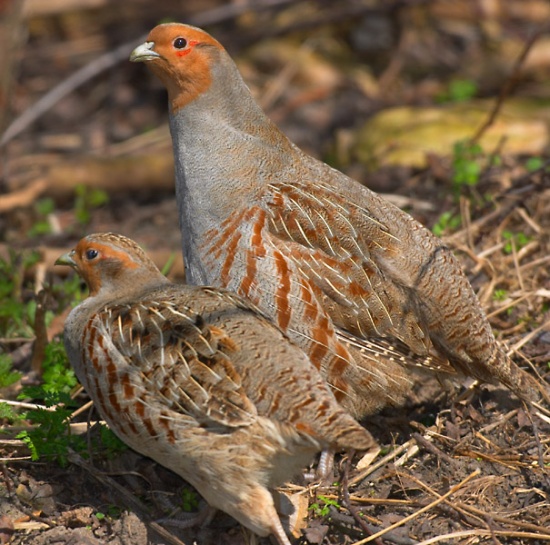- Perdix perdix
Identification
The grey partridge is native to Britain, and was once known simply as 'the partridge'. The introduced red-legged partridge became so common, however, that the pre-fix 'grey' was added. A relatively small-headed, rotund gamebird, the grey partridge has an orange face and throat, green bill and grey legs. In males, the white underbelly is marked with an obvious chestnut coloured horseshoe on the lower breast. Females are similar in appearance, but duller in colour. Grey partridges fly close to the ground, interspersing bouts of wing flapping with wobbly glides, producing a whirring noise as the wings flap. The voice includes a high, hoarse 'keev', and a 'pitt-pitt-pitt' when alarmed.
Distribution
Breeds throughout Europe from the UK to Kazakhstan, extending north to Scandinavia, with a patchy distribution in southern Europe. A resident farmland bird, in Britain the grey partridge inhabits lowland arable areas from the south chalklands as far north as Aberdeen.
Taxonomy
Habitat
In addition to farmland, the grey partridge can be found on wasteland, moors, and sand dunes. Adults prefer to occupy open grass or vegetation, but tend to move their chicks into cereal crops with abundant sources of the invertebrate food required by the young.
Behaviour
Adults feed on grass, seeds and shoots; they also take some insects during the breeding season. The young feed completely on invertebrates such as sawflies, beetles and aphids for the first 2 weeks after hatching.
The breeding season lasts between mid-April and early September. During this relatively long period, just one brood is produced; but as the clutch can contain up to 16 eggs (one of the largest clutches of any living bird species) this is perhaps understandable. If the clutch is lost, however, an emergency 'replacement brood' can be produced. Nests are usually well hidden at the base of a hedge or clump of vegetation, and consist of a scrape in the ground lined with grass and leaves. After the breeding season, grey partridges form groups known as 'coveys'.
The grey partridge was once an extremely common gamebird in Britain; before 1940 an average of 2 million individuals were shot each year. Between 1969 and 1990, however, the UK population fell by more than 50%, and a 1993 estimate put the population at 150,000 pairs. The main reason for this huge decline is thought to be changes in agricultural practices, such as the widespread loss of suitable nesting sites due to agricultural intensification. The increased use of herbicides and pesticides has reduced the availability of insect food for chicks. Furthermore, farm operations, particularly early mowing, carried out by machinery have caused massive losses of nests.
Bird Song
<flashmp3>Perdix perdix (song).mp3</flashmp3>
Listen in an external program




